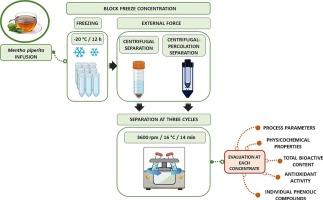探索离心渗透作为一种创新的外力在薄荷输液冷冻浓缩技术中的应用
IF 8
1区 农林科学
Q1 FOOD SCIENCE & TECHNOLOGY
引用次数: 0
摘要
本研究采用离心-渗透块冻结浓缩(CP-BFC)三次循环获得薄荷(Mentha piperita L.)输液的浓缩馏分。对其工艺参数、理化性质、生物活性成分(总多酚(TPC)和类黄酮(TFC)含量及HPLC分析)和抗氧化能力进行了评价。经过3次CP-BFC循环,分离效率和溶质收率分别接近95%和66%。此外,结果表明,渗透系统可以加入离心步骤,因此,两个分离步骤都可以成功地从冰馏分中提取浓缩溶质(11.7% w/w和13.5°Brix), TPC和TFC值分别为13.21 mg没食子酸当量/mL和15.93 mg儿茶素当量/mL。酚类化合物中香草酸、芦丁和甘樟醇含量最高。而DPPH和FRAP测定的抗氧化能力变化范围分别为47和206 μmol trolox当量/mL。这些发现(高萃取和高浓度的溶质,生物活性化合物和抗氧化能力)强调了在离心过程中添加渗透系统作为高质量液态食品浓缩的新型共生策略的潜力,有效地平衡了工艺参数和产品质量,具有半工业规模溶质和生物活性化合物浓缩的潜力。因此,由于双重分离,离心渗透是与BFC技术耦合的另一种外力,因为该过程增加并保存了生物活性化合物,以生产浓缩溶液,为各种食品,医疗和制药应用提供了无限的可能性。本文章由计算机程序翻译,如有差异,请以英文原文为准。

Exploring centrifugal-percolation as an innovative external force in block freeze concentration technology applied to peppermint infusion
This study investigates the use of centrifugal-percolation block freeze concentration (CP-BFC) at three cycles to obtain concentrate fractions from peppermint (Mentha piperita L.) infusion. The process parameters, physicochemical properties, bioactive compounds (total polyphenol (TPC) and flavonoid (TFC) content, and HPLC analyses), and antioxidant capacity of the concentrated fractions were evaluated. After three CP-BFC cycles, the process parameters were close to 95 % and 66 % for efficiency of separation and solute yield, respectively. Moreover, the results demonstrate that the percolation system can be incorporated in the centrifugation step, and thus, both separation steps carry out a successful extraction of concentrate solutes (11.7 % w/w and 13.5°Brix) from the ice fraction, with TPC and TFC values of 13.21 mg gallic acid equivalents/mL and 15.93 mg catequin equivalents/mL, respectively. Vanillic acid, rutin, and kampferol presented the highest concentration among all the phenolic compounds. While, antioxidant capacity changes ranged until 47 and 206 μmol trolox equivalents/mL, for DPPH and FRAP assays, respectively. These findings (high extraction and high concentration of solutes, bioactive compounds and antioxidant capacity) highlight the potential by adding a percolation system in the centrifugation process as a novel symbiotic strategy for high-quality liquid food concentration, effectively balancing process parameters and product quality, with potential for semi-industrial scale concentration of solutes and bioactive compounds. Therefore, centrifugal-percolation is an alternative external force to couple with BFC technology due to the double separation, since the process increased and preserved bioactive compounds to produce concentrated solutions with endless possibilities for multifarious food, medical, and pharmaceutical applications.
求助全文
通过发布文献求助,成功后即可免费获取论文全文。
去求助
来源期刊

Food Research International
工程技术-食品科技
CiteScore
12.50
自引率
7.40%
发文量
1183
审稿时长
79 days
期刊介绍:
Food Research International serves as a rapid dissemination platform for significant and impactful research in food science, technology, engineering, and nutrition. The journal focuses on publishing novel, high-quality, and high-impact review papers, original research papers, and letters to the editors across various disciplines in the science and technology of food. Additionally, it follows a policy of publishing special issues on topical and emergent subjects in food research or related areas. Selected, peer-reviewed papers from scientific meetings, workshops, and conferences on the science, technology, and engineering of foods are also featured in special issues.
 求助内容:
求助内容: 应助结果提醒方式:
应助结果提醒方式:


